Fund for Teachers Fellow 2019
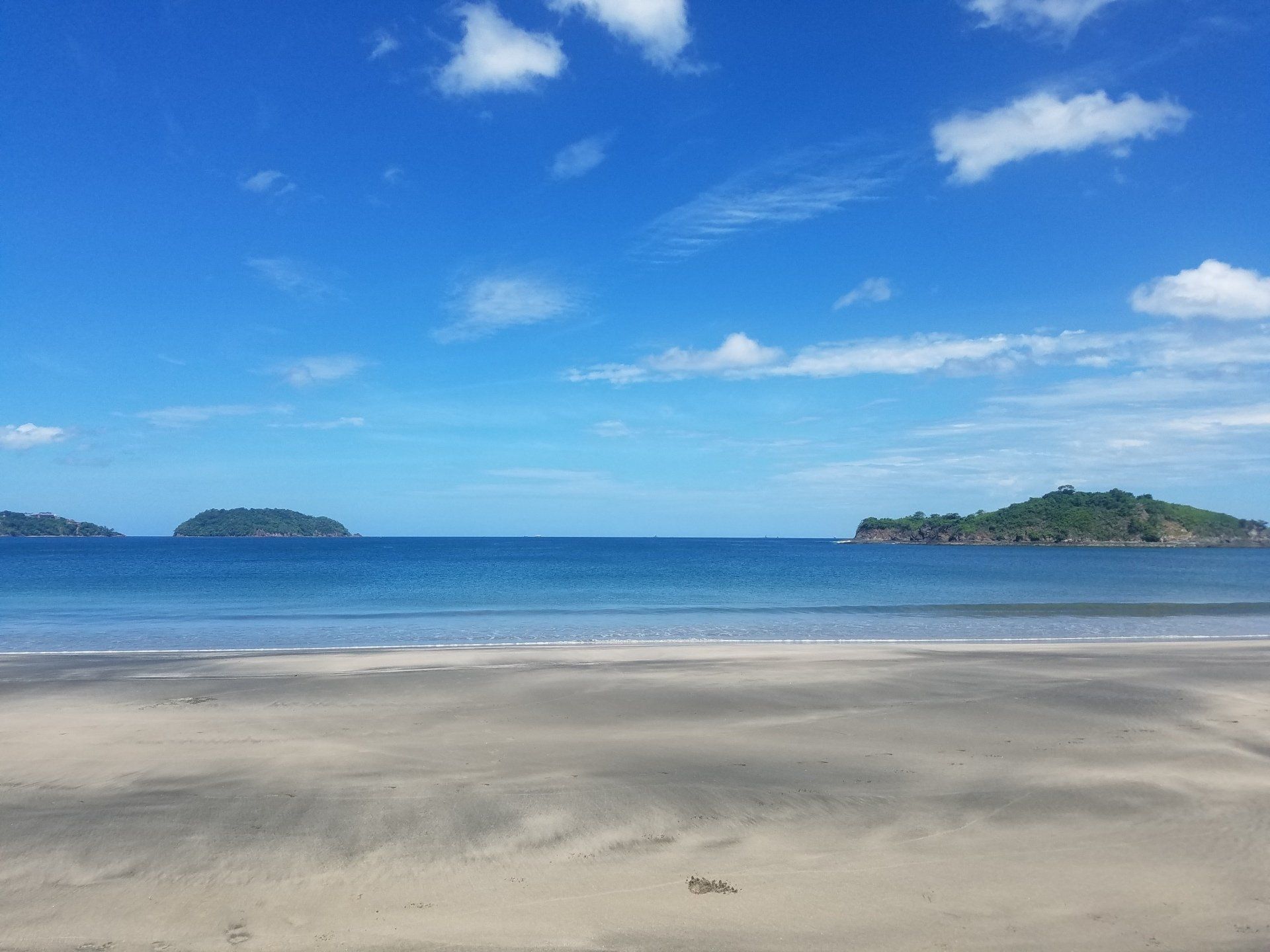
Life in rural Potrero Beach is much different from urban San Joaquin de Flores, where I spent my first two weeks in Costa Rica. San Joaquin de Flores is an urban area where the homes are behind locked gates with security bars. These gates often have barbed wire on top of the bars or other structural features that prevent people from climbing over the gates. My host family's house there was behind a gate along the sidewalk that was indistinguishable from those around it. One night when I returned home at dusk, I had great difficulty finding their gate, which was a bit frightening, since the gates don't have house numbers on them - my address just read "from the community center, go 20 meters to the south). Once inside the gate, there are four houses around a courtyard-type area with clotheslines and an area for the dogs to play. Relatives live in two of the other houses behind the gate. Once I entered through the gate in the evening, I did not venture out of the house unless it was within the courtyard with family. In Potrero Beach, the houses are not behind security gates. It is a pueblo with everything that is needed within a 3 minute stroll of the house. A friend at CPI told me that every pueblo has a plaza (soccer field) at the center, surrounded by a church, a market, and a school. Potrero Beach has all of these (two markets, actually), and a community center on the plaza, too. In addition, it has a pretty beach with dark volcanic sand right next to the community center. It is safe to stroll around at all hours and the streets are filled with neighbors who greet each other and visit on porches for hours on end. The school is next door to our house and has three classrooms, though it is so tiny compared to schools at home. Grades 1-3 are taught in the morning from 7:00 to noon. As I walk to my CPI bus just before 7:00 AM, I see all of the parents dropping their children off at school, walking, in cars, as well as bikes, and motorcycles/scooters. I saw one family on a motorcycle with four people on it the father was driving, the student was in the middle and the mother sat on the back with a toddler! It seemed like a lot of people on a small motorcycle. The students in grades 4-6 are taught in the afternoon from 12:00 to 4:00. After school is dismissed at 4:00 PM the students walk across the street to play pickup soccer games in the plaza. When I get off the bus from CPI about 4:45, Kattia is always sitting on her friend’s porch which looks out on the plaza. She waves me over to join them and we just sit and talk for awhile. It’s very laid back, no one rushes. My host families have not even owned cars, they just walk where they need to go, or take the bus. In Potrero Beach we walked for ice cream after dinner a couple of times. It was about a 10-15 minute walk down dark, unpaved roads. There were very few street lights and cars drove by regularly. There are no sidewalks and the edge of the road falls off into a drainage ditch so it is important to stay alert. I would have been nervous but my host family did not seem fazed walking in the road after dark, so I just went with it. The lack of street lights was actually a bonus because the stars were much more visible than at home. When we arrived at the ice cream shop, I was stunned to find that it was an authentic gelataria with delicious, authentic gelato. I wondered how such a tiny town in Costa Rica found a following for real gelato, until Kattia filled me in. The shopping plaza where the gelataria is located is home to apartments that are almost exclusively owned or rented by Italians who come to Costa Rica during the cold months in Italy. According to Kattia, the Italians are one group of many foreigners who live in the area, including citizens of the United States, Canada, and Nicaragua. When I was in San Joaquin de Flores, I noticed that dogs are rarely on leashes, and they do not stay in fenced yards, and it is the same in Potrero Beach. They are free to roam around, which made me nervous for them when I was in San Joaquin de Flores where there is lots of traffic and the cars honk at, rather then slow down for, anyone or anything in the street. I felt like I was risking my life every time I crossed the street there and I worried about the dogs a lot. My friend said not to worry and pointed out that we don’t see dead dogs in the street, but I'm not sure that that is a good measure of their safety. Although the dogs seem happy, I can’t stand seeing them wandering among moving cars. In Potrero Beach, I am awakened by roosters crowing and cows mooing, a lot. I also have been hearing what I thought was incessant barking of packs of dogs, but Kattia told me that the sound is actually the monkeys. Animals are everywhere. Kattia’s uncle lives next door and he has many animals. and, while she doesn’t call it a farm, it certainly meets my definition of one. I asked her about his cows and she said that he just likes to have them, he does not raise them for beef and rarely milks them. One night at about 8:00 PM, the mooing next door seemed to be getting louder and closer to our house. Kattia told me to go outside just as the cows passed by in a line on their way to the mango tree next to the school where they feasted on the mangoes that had fallen to the ground. When they finished with that tree, they proceeded throughout the neighborhood to find more fruit. When they were finished, they came back in a line. The lead cow was very big and when the little stragglers fell too far behind he turned around and let out a very loud “moo” and the line progressed toward home. Kattia’s grandmother owned a lot more of the surrounding area in the past, but over the years they have sold some of it off to people who have built houses there. There are mango trees all over, so there are lots of mangoes in the street. I didn’t know what rotting mangoes smelled like, but now I do. I am surprised at how abundant they are. There are also coconuts in yards. We have a pile in our front yard.

July 15, 2019 I was nervous to meet my new host family, but as soon as I arrived my fears were put to rest. My new home is at the beach and my new Mama Tica, Kattia, is so relaxed - she speaks slowly and clearly, and I don’t have problems communicating with her at all. I was kind of hyped up when I got to her home, I think because it's my natural state and Heredia had a "go-go-go" vibe. Kattia said “tranquila, tranquila” many times in our first conversations and, after a while, I started to feel like she was like a yoga teacher, because I caught the relaxed state that seems like her way of life. I felt much more tense in Heredia. Maybe because this is a clean slate and Kattia didn’t see my earlier struggle with the language, but I am more relaxed now. Kattia has a daughter Valeria who is 11 years old - she is learning English and helps me when I can’t remember a word. Today, I started my new classes and Valeria helped me with my homework, before she even finished her own! :) My new house is right next to Valeria’s school. It is a three-room schoolhouse. She attends classes in the afternoon, starting at noon, and the primary grades attend school in the morning. In the school yard there is a mango tree. When I walked by and noticed that mangoes were falling from the tree, my Mama Tica pointed out that it was monkeys - the tree was full of them. They were feasting on the mangoes and swinging from branch to branch. One monkey had a baby on her back and still managed to jump from tree to tree. There are also several roosters and hens in the yards of the homes adjacent to mine. On one side, there are also many baby chicks. The roosters begin crowing about 4:50 in the morning which ensures that I will not be late for school. In my previous host family’s home, I could hear a few roosters at about the same time in the morning, but here there are so many more animal sounds at all hours. The neighbors also have cows. It is considered a rural area, but everything that you need is located a few steps away. There are two markets within blocks of the house, a barbershop, and the community center which has exercise classes. Last evening my host “sister” asked if I wanted to go to exercise class at the community center at 6:30 PM, about 10 minutes before the class would begin. I contemplated going as I could walk to the community center in under a minute, but then a torrential downpour started. While it was raining very hard, the sound was so loud, you could barely have a conversation. I then realized that the ceiling is also the roof of the house, there is no attic in the house, so the rain sounds much louder than it would ordinarily. We did not end up going to the exercise class due to the heavy rain.
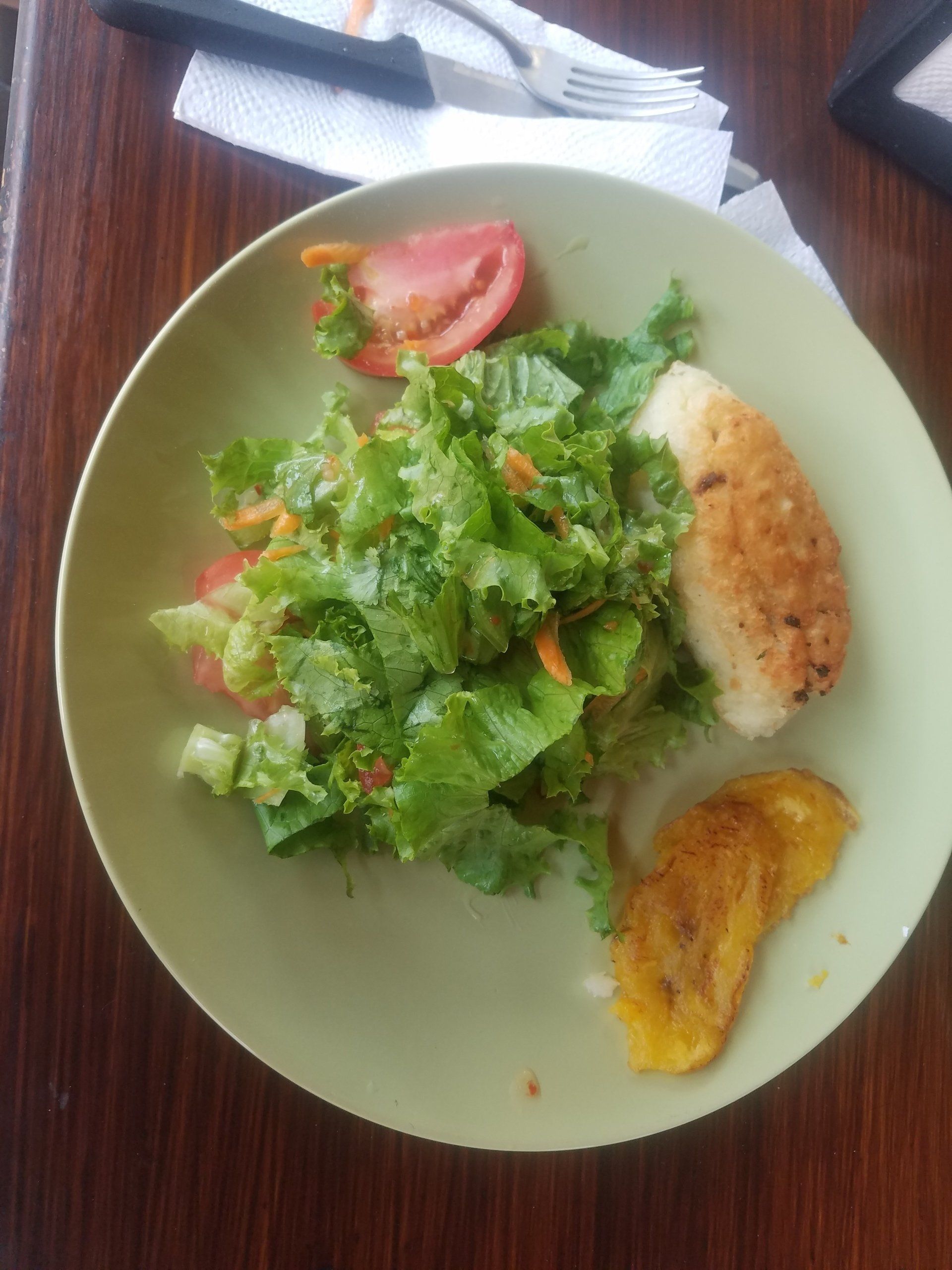
On Wednesdays at CPI Heredia, cooking, dance, and exercise classes are always offered. My second week there, I looked forward to attending them again, but my sneakers were still soggy from walking in the rain around San Juan de Flores the previous Monday. I had used an umbrella, but my backpack and shoes were completely soaked and took a few days to dry out. I attended the cooking class and we made a very delicious meal of seasoned ground meat inside of a yucca cake that is pan fried. We also had fried plantains and a salad. I have seen yucca root in the grocery store before, but never knew what it was used for and now I know one way to use it in cooking. In the dance classes we continued our work on the salsa and merengue. I was the only student from the previous week so I welcomed the refresher since I need a lot of reinforcement to learn the dances.
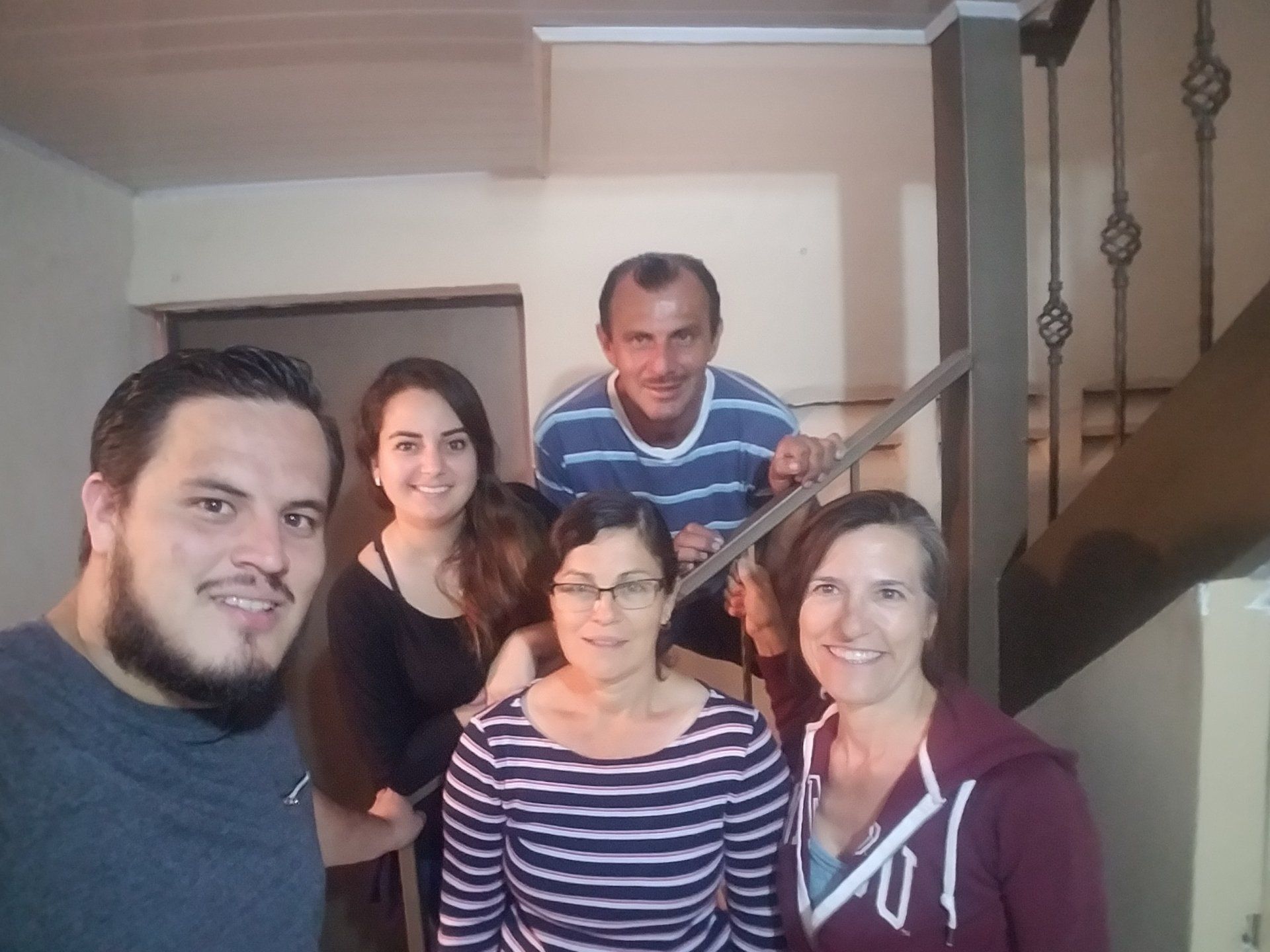
On Sunday, July 14th, I had to say “goodbye” to my host family in San Joaquin de Flores, to head for my final two weeks of study at the CPI School in Flamingo Beach. My hosts generously included me in their family gatherings and I enjoyed their company tremendously, so it was very difficult to leave. My last weekend there was filled with activity, so I did not have too much time to struggle with moving on. On Friday after class, I toured Zoo Ave. which is an animal rescue sanctuary featuring botanical gardens and wildlife (birds mammals, and reptiles) that have been rescued for health or behavior reasons. After returning from Zoo Ave. I went with a group of students to a street festival in downtown Heredia. There were performers, crafts, specialty foods - and music! It was a treat to get out in the town at night, since all of my previous excursions had been during the daytime. Afterward wandering around the festival, the group went to dinner at a restaurant and enjoyed some typical Costa Rican cuisine. Saturday morning, I went white water rafting on the Sarapiqui River with two friends from CPI. I had never been rafting before and it definitely lived up to the hype. Our guide, Enrique, grew up in the area and told us all about the wildlife around us - mostly birds (that we do not have at home) and iguanas. He also reached up and plucked a guava from a tree overhanging the river, sliced it, and served it to us as we floated along. It was the perfect way to spend my last full day in the area. I returned to my host family’s house in time to accompany them to a neighbor’s house (who is also the sister of my Papa Tica). They were gathering for the third anniversary of the death of their father and it was very similar to the ceremony that I attended with them at another neighbor’s house (also a relative), when I arrived. I was a little confused the first time that I went to the ceremony because I knew it had something to do with someone who died, but my Spanish conversational skills were not sufficient to determine the whole story. After improving, I was able to understand what was going on this time. The first ceremony was a gathering which takes place in the year that a family member dies. The family gathers once each month for prayers. After the first year, the family gathers once per year on the anniversary of the person’s death for a similar ceremony. After both ceremonies, the hosts serve dinner to everyone in attendance. The gathering on Saturday was much smaller than the one that I attended the first week. This time I was seated right in front, across from Mama Tica who, along with her sister-in-law, took turns reciting the prayers. Being in the main room allowed me to see that at the front there was a picture of the entire family with a candle in front of it. When the prayers were completed I was invited to join the family at the main table in the dining room where I had the chance to talk with Papa Tica’s sister and brother-in-law. I was given a heaping plate of delicious food but could barely make a dent in it, as I spoke with the brother-in-law. He suggested that he let me eat, since everyone else was finished, but I explained that I have been eating three meals a day in Costa Rica with a lot of starch that I am not accustomed to and I am trying to keep up but didn’t think I could finish. He responded that it was good that I was eating more than at home and that I could get fat in Costa Rica - as if it would be a positive outcome. I thought that was pretty funny because it reflects a point of view that I would never hear at home. I found that these religious-centered family events provided opportunities for the entire family to get together, share a meal, and honor the memory of relatives. I notice that the Catholic culture here is different from my experience as an American Catholic. My Mama Tica listens to prayer novenas on the radio some mornings and their home has many religious items such as crosses and figures throughout. In addition to attending weekly mass, she also watches the religious programming on weekends. There is a very small church across the street from my family’s home, which they attend - but it is not a full-service church - for example, this past Sunday, they did not have mass, so the family also attends the church on the plaza in San Joaquin de Flores. When I toured the churches in San Jose, Heredia, and Sarchi, I noticed that they were in the style of European churches, but with fewer ornate details. I discussed this observation with two Catholic bishops from Quebec who are studying at CPI with me. They agreed that the churches are much more "humble" than those in Europe. One of the bishops shared his observation that the depictions of Christ in these churches featured much more blood and appearance of anguish than are seen in other places. He thought that the depictions of suffering reflected the suffering felt by the people in this region at the time they were created. The bishops attended mass on Saturday with their hosts and one shared that he was surprised to see a congregation filled with black-haired people, whereas in Quebec he looks out to a sea of white hair. Apparently religion is very strong among the young people here as compared to the population of Catholic churchgoers in the U.S. and Canada. The bishops were invited by the priest to perform the mass, including the homily, which had to be written in five minutes - all in Spanish. They managed to do it, which impressed me tremendously and demonstrates how much we are learning here at CPI! I asked the bishops about their motivation for studying Spanish, since they are already bilingual in French and English. They said that they had recently become bishops and that when they went to the Vatican for the ceremony, they found that of their class of approximately 160 bishops, a large percentage spoke Spanish, so they decided it was important to develop their Spanish language skills. While a lot of the other students at CPI are teachers and professors, I have also met nurses, doctors, a judge, high school and college students, and people who just want to learn.
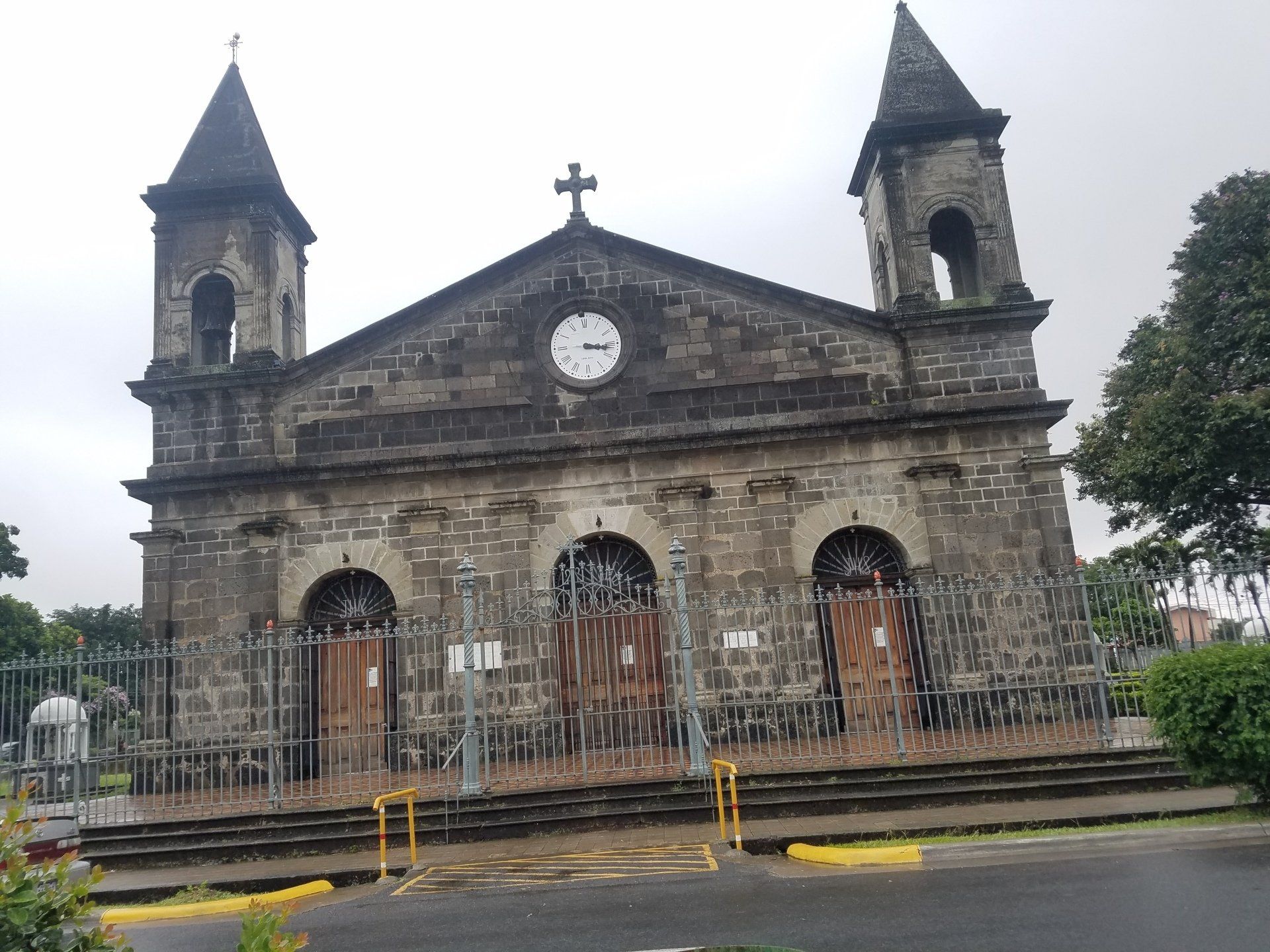
Monday, July 8 Today was the first day that I did not have a planned excursion after class so I finally had time to exchange some of my dollars for Colones and buy a notebook for all of my class notes. Until today I have just been using my folder but it’s time for a real notebook. It was my first opportunity to venture out alone in San Joaquin, which is the small town where CPI is located. The school’s website describes the location as a typical town and I find that I am surprised by aspects of the area that I did not expect. Some observations: Most of the streets do not have names - even on my map! Since my phone only works on wifi here (I didn’t want to pay for data), I used a paper map to find my way around and had to count the streets from where I was at any given point to find my way around. All of the residences are behind locked metal security bars. As I walk around, I do not see a single home without bars and a locked gate in front. It is often hard to find the gate for my host family's house, since there is not much differentiation between gates and...just as the streets do not have names, the gates don’t have numbers on them. Trash is not put out at the curb in barrels. The homes have metal boxes on posts by the curb where they put their trash bags for pickup. It is not easy to find a notebook here. I looked in many stores that would possibly have paper - many stores had wrapping paper for sale - but no notebook paper. I went into the pharmacy and asked because I saw wrapping paper, but they did not have what I needed. I went to the large grocery store called Pali - it did not have paper. While there I saw they carried Equate branded products, which is Walmart’s house brand. This store is owned by Walmart, but it only sells food and personal items. Security is much different here. To get into the bank to exchange money a guard had to unlock the door. He then inspected my backpack in the lobby of the bank before allowing me to enter. I stood in a line until the guard pointed to the line on the floor indicating where he wanted me to stand. Many businesses do not have regular storefronts where customers can come and go. On my walk to school, I pass what appears to be a home with laminate flooring samples in front - without a sign for a business or any other indication that a business is at the location. Another student at CPI told me that many businesses operate by appointment only and that is perhaps the case with this flooring business. There are several fried chicken restaurants in the town. I probably passed about five of them during my walk today. My host mother, mama Tica, said that fried chicken is very popular here. My map indicated that there would be a plaza in town, so I expected a big open area with shops around it, but that is not what I found. The plaza is a square soccer field - which makes sense after checking out my vocabulary book which shows that the word “plaza” is Spanish for soccer field. This is something from my host family’s house that I found very interesting. The washing machine is “semi-automatic”. After the clothes are washed, they are put in the spinner on the right side of the machine by hand and then the spinner can be turned on to spin the clothes. My “mama Tica” said that she prefers semi-automatic to automatic and I can see a big advantage to this kind of machine. The clothes are immersed in the basket full of water and get a lot more agitation than I have seen on fully automatic machines.
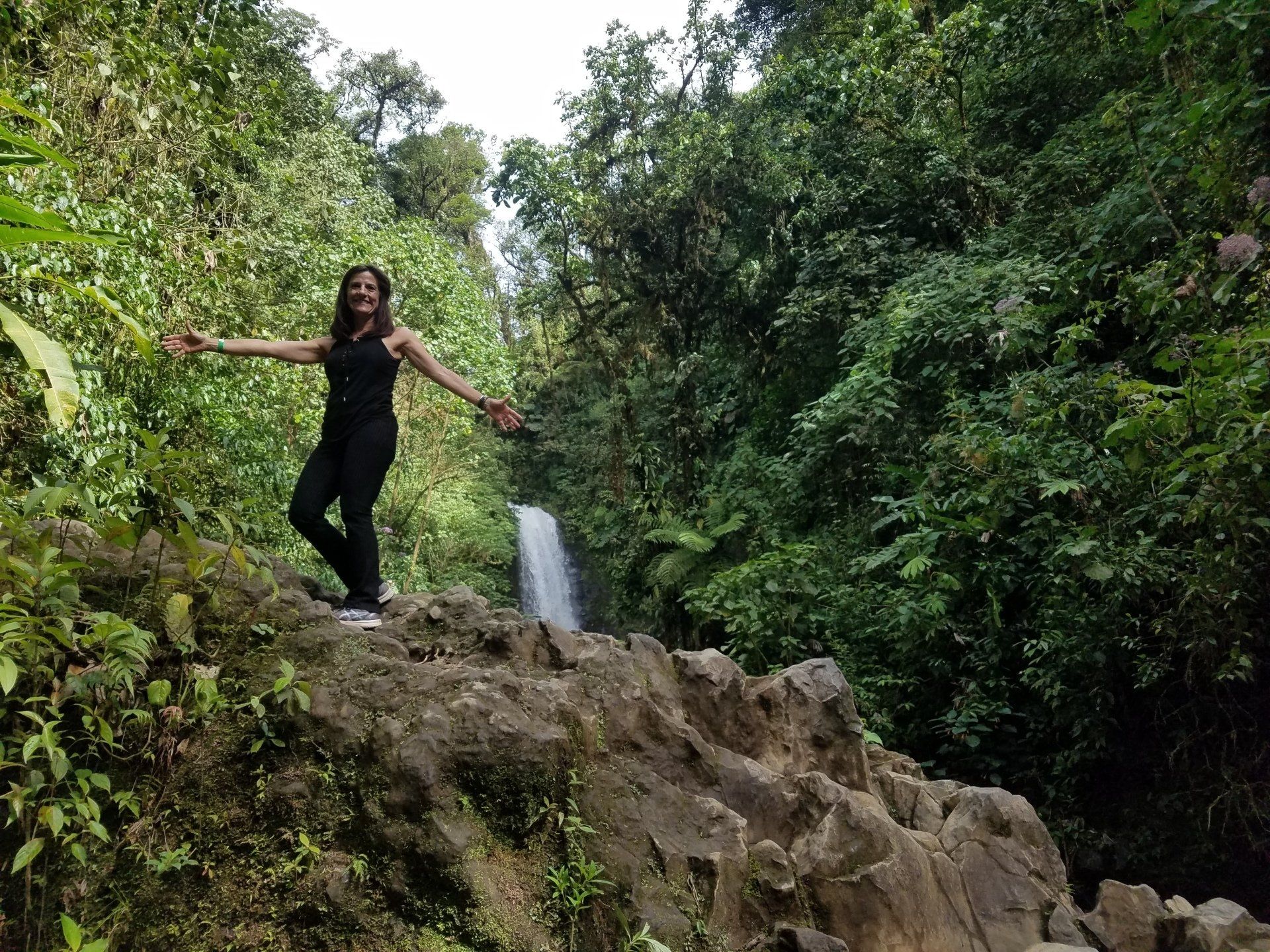
The Costa Rican landscape features dramatic shifts between coastal plains and volcanic mountain ranges, so the views of waterfalls are a popular attraction. The Spanish word for waterfall “catarata” is on many of the signs - so I learned a new word and do not have to rely on Google Translate which does not show this word as a translation. It shows for the first word “cascade”, but the other suggestions include “cataract”, which I’m pretty sure is the app's attempt at “catarata”. This experience serves as a cautionary tale about the reliability of this translation resource. This past Thursday after classes, I visited the La Paz Waterfall Gardens in the province of Heredia, about an hour drive from CPI. The trip offered vigorous hiking to see all of the waterfalls, as well as a guided tour of the wildlife preserve there. The afternoon was educational and featured the gorgeous scenery that is a primary attraction for Costa Rica. Here are photos from my trip to La Paz:
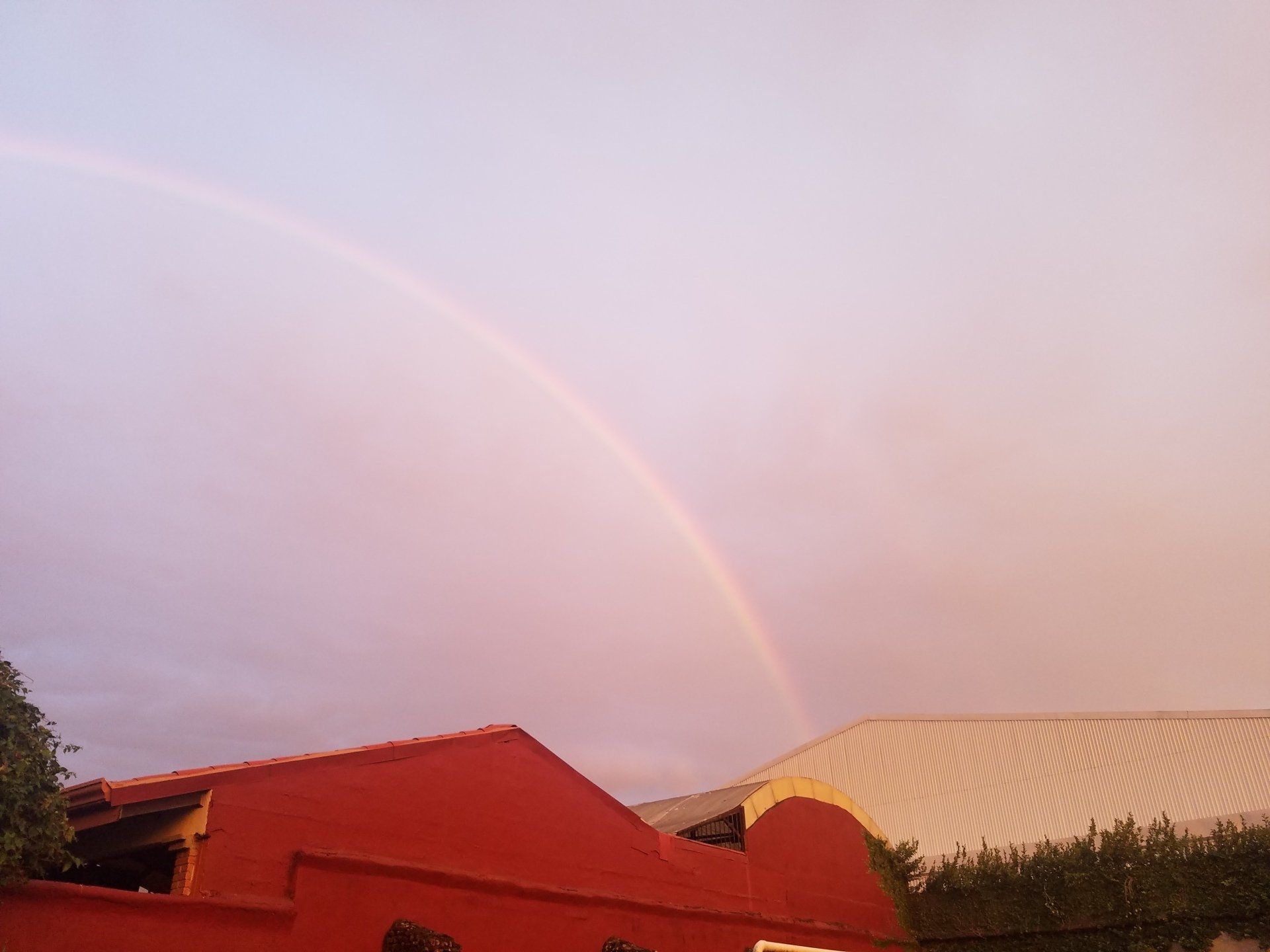
CPI offers many opportunities to learn about the local culture, and I took advantage of every cultural class offered at the school today. The first activity offered after class was a cooking class. I participated in it with about 7 other students. We cooked our own lunch of traditional Costa Rican food under the direction of staff members.

When I was awarded my Fund for Teachers Fellowship, I received a journal from the Dalio Foundation with a Mark Twain quote on the cover, which became more significant to me as the trip I planned was becoming an intimidating reality. These words from the quote were a helpful reminder as I began my adventure: “Twenty years from now you will be more disappointed by the things that you didn’t do than by the ones you did do. So throw off the bowlines. Sail away from the safe harbor. Catch the trade winds in your sails. Explore. Dream, Discover.” As I prepared to leave the comforts of home to live with strangers in an effort to improve my Spanish language skills, I needed to remember the importance of embracing the unknown. When I decided to plan this language learning experience in Costa Rica, I felt pretty confident that my knowledge of the Spanish language was strong and that immersion into the Spanish-speaking world would help me to unleash my inner fluent speaker. Upon my arrival at the home of my host family, when they told me that they, in fact, spoke no English,the magnitude of my challenge dwarfed my remaining optimism. I had traveled all day and could barely make myself understood. My hosts were very kind, but my inability to communicate effectively was unnerving. I have now completed my second day of classes and am pleased that I can now carry on simple conversations with my hosts - Mama Tica Alexandra and Papa Tica Jairo. At least I am no longer so flustered that I forget to ask “como se dice?” (I know "como" needs an accent but I'm still working on the keyboard skills). Living with this family has given me cultural insights that I could not have gotten staying in apartment or Airbnb. On Monday night, my first full day here, Alexandra and Jairo took me next door to a relative’s house for a funeral ceremony. Sarah, a student who is staying with the family, told me (in English) that the ceremony was for the 30th day since the death of a relative (I wasn’t confident enough in my Spanish skills to ask my hosts at the time). The house was set up with white folding chairs and there were flowers at the front of the room. When we arrived the room was already full, so we sat in chairs arranged in an adjoining room - it felt like being in the overflow room at church, where you can hear the “action” but can’t see it. The ceremony had already begun and someone was leading a prayer and then the group would respond. It went on for awhile and I participated to the best of my ability - repeating “Santa Maria” with the crowd and feigning understanding by moving my mouth for the remainder of the recitation - a move perfected in elementary school music class when I forgot the song lyrics. Afterward the family swiftly served a dinner of Costa Rican Tamales, marinated vegetables, and coconut cookies to everyone. I wish that I had pictures to share, but it seemed inappropriate to take photos in that setting. Yesterday, after class I went on a city tour of Heredia, the city where my school Centro Panamericano de Idiomas is located. Today, I toured Cafe Britt, the first gourmet coffee roaster in Costa Rica. Our tour guides explained how the growing conditions in Costa Rica support the production of the best quality coffee and I learned techniques to identify the aromas and flavors in coffee.
